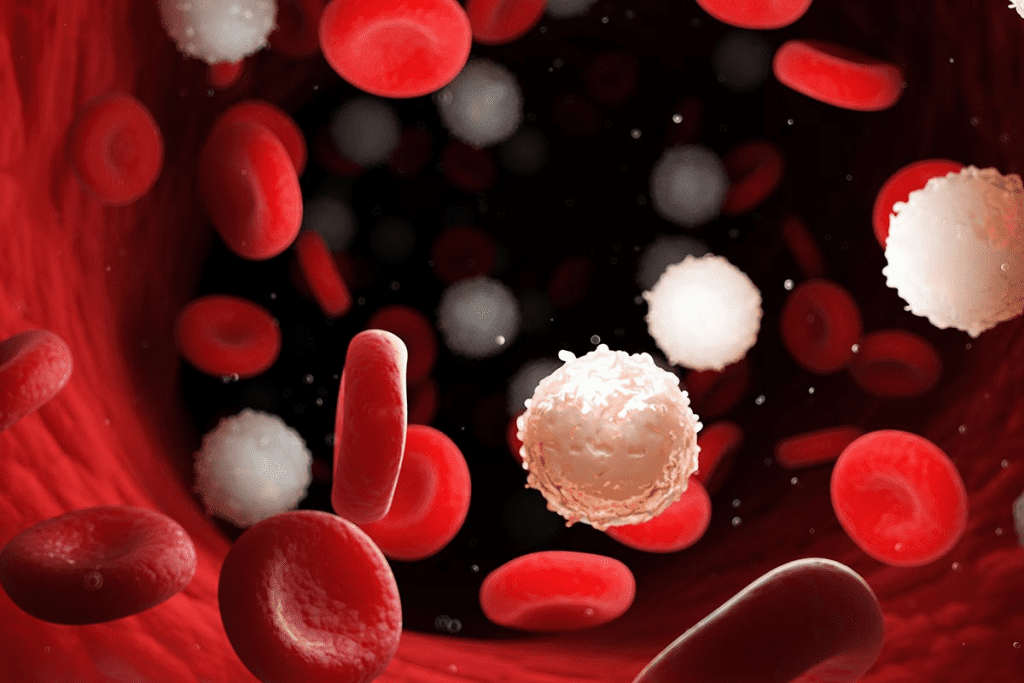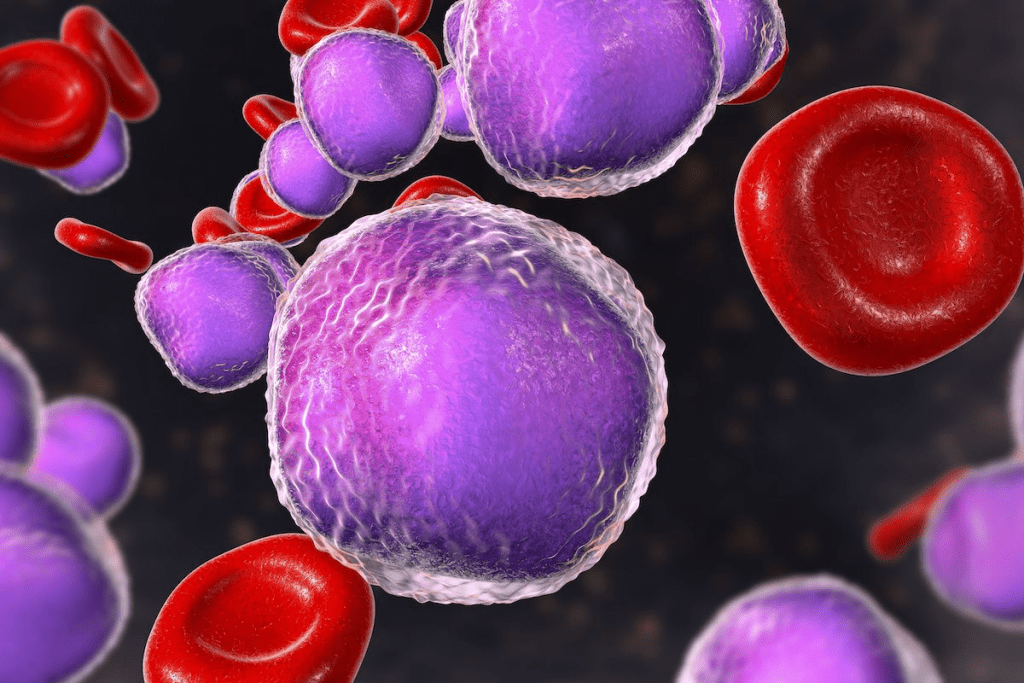Last Updated on November 13, 2025 by
Leukemia is a serious blood cancer that affects the bone marrow and blood cells. The American Cancer Society says about 66,890 new cases are expected in the US in 2025 & early signs of leukemia in blood work. Look out for symptoms like constant tiredness, frequent infections, easy bruising, and ongoing pain in bones or joints.

Knowing how leukemia is diagnosed through blood tests is key. A blood test can show abnormal cell counts, hinting at leukemia. Quick diagnosis and treatment can greatly help patients. By spotting early signs and understanding how it’s diagnosed, we can start effective care.
Leukemia is a silent cancer of the blood. It can sneak up on you, making it key to know its signs. We’ll look into leukemia’s development, types, and why catching it early is so important.
Leukemia is a cancer that messes with the blood and bone marrow. It’s caused by abnormal white blood cells growing out of control. These cells take over, making it hard for the body to fight off infections.
Genetic mutations play a big role in leukemia’s development. They mess with how blood cells are made, leading to bad cells building up.
What causes leukemia isn’t fully known. But genetic predisposition, certain chemicals, and radiation are risk factors. Knowing how it starts helps us spot risks and prevent them.
There are many types of leukemia, each affecting different cells and progressing at different rates. The main ones are:
The National Cancer Institute says CLL is the most common in the US. Knowing the types helps doctors choose the right treatment.

Finding leukemia early makes treatment more effective. Early detection can lead to better survival rates. Thanks to better detection and treatment, survival rates for leukemia have gone up.
For example, kids with ALL have a much better five-year survival rate than adults. This shows how critical early detection and the right treatment are.
Leukemia often shows up with symptoms that can lead to early diagnosis. Knowing these signs is key to quick medical help.
Fatigue and weakness are common leukemia symptoms. This tiredness doesn’t get better with rest and can affect daily life. Women often see this as the first sign of leukemia, sometimes thinking it’s something else.
Leukemia patients often get infections because their immune systems are weak. The Mayo Clinic says these infections can hint at leukemia. Getting infections even when treated should make you check further.
Leukemia can cause unusual bruising and bleeding. This happens because it affects platelet production, which is key for clotting. Easy bruising or bleeding gums can be an early sign of leukemia in women, needing a doctor’s check-up.

Leukemia can cause bone and joint pain because cancer cells build up in the bone marrow. This pain can last and not have a clear cause, leading to more tests.
Leukemia patients might lose weight and have night sweats. These symptoms are not specific but can hint at leukemia when seen together. Significant unexplained weight loss and night sweats need a thorough check.
In summary, knowing these five symptoms can help spot leukemia early. If you or someone you know has these symptoms, getting medical help is vital. Early signs of leukemia in blood work include abnormal white cell counts, anemia, low platelets, and unusual patterns requiring timely medical evaluation.
Blood work is key in finding leukemia. It shows signs of the disease through different tests. These tests are important for spotting leukemia early.
A Complete Blood Count (CBC) is a basic test for leukemia. The Canadian Cancer Society says it checks white, red blood cells, and platelets. If these counts are off, it might mean leukemia.
These CBC issues are important signs of leukemia.
There are also biochemical markers that show leukemia might be present. These include:
Spotting these signs early is vital for treating leukemia. Knowing what these signs mean helps doctors diagnose leukemia better.
In 2025, we’ve made big strides in finding leukemia early. We’ve found four new signs that help us spot it sooner and more accurately.
Mild anemia is now seen as a key sign of leukemia. Anemia that lasts and has no clear reason is a red flag. Even mild cases can be a sign of leukemia if other symptoms are there.
Unexplained thrombocytosis, or high platelet count, is also important. It can mean many things, but without a clear reason, it might mean leukemia. Doctors are now looking at leukemia when they see this.
High inflammatory markers, like CRP, without infection, are signs of leukemia. These markers show there might be a blood cancer. We’re telling doctors to think of leukemia in these cases.
Small changes in blood smear results are being looked at closely. These tiny signs can mean early leukemia. Hematologists are being told to watch for these signs for early diagnosis.
By spotting these four new signs, we can find leukemia sooner. This could lead to better treatment for patients.
Some groups are more at risk for leukemia. They should watch out for unusual symptoms. This includes people with a family history of leukemia, those exposed to harmful chemicals or radiation, and those with certain genetic disorders.
Certain symptoms together mean you should see a doctor right away. Look out for fatigue and unexplained weight loss, frequent infections and unusual bruising, or bone pain and night sweats.
Delaying leukemia diagnosis can harm treatment success. A 2-6 month delay can mean the difference between early and late-stage diagnosis. This affects treatment effectiveness and patient outcome.
Consequences of delayed diagnosis include:
Doctors use several methods to decide when to test for leukemia. They look at symptoms, medical history, and lab tests. This includes checking complete blood counts and considering risk factors.
Knowing when to seek medical help and understanding risk factors and symptoms can lead to earlier diagnosis. This can improve treatment success.
When leukemia is suspected, acting fast is key to good treatment and better health. The American Cancer Society stresses the need for early detection and treatment. We’ve talked about early signs in blood work that might show leukemia.
If you’re worried about leukemia symptoms, see a doctor right away. Early diagnosis is vital. Doctors decide when to test for leukemia based on symptoms and risk groups. By being quick to act, we can help patients get better and support them on their recovery path.
Early signs of leukemia include persistent fatigue and frequent infections. You might also notice unusual bruising and unexplained bone and joint pain. Catching these symptoms early is key to getting the right treatment.
Doctors use blood tests, like a Complete Blood Count (CBC), to diagnose leukemia. They look for any abnormal results that could point to the disease.
Leukemia comes in several types, including acute lymphoblastic leukemia (ALL) and acute myeloid leukemia (AML). There’s also chronic lymphocytic leukemia (CLL) and chronic myeloid leukemia (CML). Each type has its own traits and affects people differently.
Catching leukemia early is vital for effective treatment. Waiting too long can make symptoms worse and limit treatment choices.
Red flags in lab tests for leukemia include anemia, low platelets, or high white blood cell counts. Elevated lactate dehydrogenase (LDH) levels are also a warning sign.
New signs of leukemia include mild anemia and unexplained high platelet counts. Also, look out for high inflammatory markers and small changes in blood smears.
Some people are more likely to get leukemia. This includes those with a family history, exposure to harmful chemicals or radiation, and certain genetic conditions.
If you have persistent fatigue, frequent infections, unusual bruising, or unexplained weight loss, see a doctor right away. These symptoms could mean leukemia.
Waiting too long to get diagnosed can make symptoms worse. It also limits treatment options and can lead to poorer health outcomes.
Doctors look at your symptoms, lab results, and risk factors to decide if you need a leukemia test. They consider all these factors together.
Subscribe to our e-newsletter to stay informed about the latest innovations in the world of health and exclusive offers!